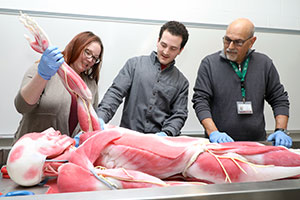SynDaver provides students a realistic look at the human body
April 24, 2019

Students Jenna Steinle and Ben Lippett look over CCRI’s SynDaver with Assistant Professor Paul Miele.
At 5-foot-1 and a mere 90 pounds, she’s changing the way students at the Community College of Rhode Island study anatomy.
Tucked away in the newly renovated biology lab at the Knight Campus, CCRI’s synthetic cadaver – or SynDaver for short – is a lifelike, full-scale model of the human body, complete with all bones, muscles, joints, tendons and organs.
Syndi, as the students named her, is built with synthetic material designed to mimic all the properties of live tissue, so each muscle, tendon and organ feels like that of a real human. She’s also flexible, unlike traditional plastic models, so students can peel back layers of muscle and closely examine the arteries and tendons.
CCRI and the University of Rhode Island are the only institutions of higher education in Rhode Island with a SynDaver, and Assistant Professor Paul Miele says the new technology offers students in health sciences and related fields a much more realistic look at the human body, from identifying vital organs to understanding muscle and joint movement.
CCRI purchased the SynDaver in October and began using her at the Knight Campus this semester in its Human Anatomy (BIOL 1010) and Human Physiology (BIOL 1020) courses. Each campus will eventually have its own model. With the proper care, which includes “bathing” her every two weeks in a special solvent used in swimming pools and spas to prevent algae growth, Miele says Syndi will last forever.
“This has taken us into the 21st century,” he said. “The SynDaver gives students a three-dimensional view of what the human body is doing. They can actually grab the muscle. Once they know function, they remember where it is. They’re learning the muscles so much better.
“The students are the ones that are reaping the benefits,” Miele continued. “You’ve got to see their faces the first time they see it. They’re ecstatic. I’ve had students from other science classes coming in here just to see her.”
With support from Vice President for Academic Affairs Rosemary Costigan, Miele pushed for CCRI to acquire SynDavers more than a year ago, citing other community colleges whose students enjoyed “a 25 percent increase in grades” through use of this state-of-the-art technology.
The cost – including its custom storage tank and support table – is between $75,000 and $80,000, but Miele knew students would benefit from using a lifelike synthetic model in the classroom.
“That was the big thing for me – to get more kids to pass this course and move on instead of taking it over again,” Miele said.
Because anatomy and physiology are prerequisites for many students in the health sciences field, a variety of future health care professionals find Syndi a useful learning tool for understanding all the quirks and nuances of the human body, whether they’re studying dentistry or physical therapy.
“We have a lot of nursing students, so this is perfect,” Miele said. “The physical therapist assistant students can see the function in the muscles. The hygienist can actually go in its mouth to see the buccal cavity, the teeth alignment and all of that.”
Warwick native Ben Lippett, a URI graduate, enrolled in CCRI’s BIOL 1010 course this semester to brush up on his anatomy before he transfers to Case Western Reserve University in Ohio to pursue a career as an anesthesiology physician assistant. The SynDaver features the same veins and arteries found in the human body, which gives him a better understanding of what he will encounter once he begins clinicals within a year or two.
“As an anesthesiology P.A., you’re doing a lot of nerve blocks. With the SynDaver, you get to pull apart the muscles and see where you’re going to inject a paralytic into,” Lippett said. “You get to see all the muscles as is. You get to see all the nerve endings. You get to just see how the joints work. You get to pull all the muscles back and see deeper into the body than what you would with a plastic model.”
Jenna Steinle of Coventry took BIOL 1010 two years ago and has been tutoring students in Miele’s class ever since. She is studying sonography and hopes to work in the cardiology field performing echocardiograms, which are ultrasounds of the heart.
“This is what a lot of us being in the health care field are going to need to know every bit of, so this helps so much more than just a plastic model. Being able to use SynDaver to feel around the mouth, the esophagus, you can’t really compare that to a plastic model.”
CCRI’s Biology Department is rebranding its prerequisite courses in 2020 to mirror URI’s curriculum, so the addition of the SynDaver is not only helpful, but essential in allowing students to fully complete the course load. Syndi’s arrival ushers in a new era of learning, benefiting students in all health care fields, from nursing and occupational therapy to respiratory and cardiology.
“A year from now, these students will be doing their clinicals,” Miele said. “Having worked with the SynDaver as part of their course work will give them a leg up.”